Analysis of Rock Burst Mechanism in Extra-Thick Coal Seam Controlled by Thrust Fault under Mining Disturbance
Abstract
:1. Introduction
2. Engineering Background
- (1)
- Geological structural characteristics of the Gengcun coal mine
- (2)
- Developmental characteristics of the F16 fault
3. Mechanical Analysis
3.1. Mechanical Model
3.2. Rock Burst Mechanism
4. Numerical Simulation
4.1. Model Construction and Rock Mechanics Parameters
4.2. Simulation Results and Discussion
4.2.1. Evolutionary Law of Supporting Stress and Surrounding Rock Stress of the F16 Fault
- (1)
- Figure 9 shows that stress concentration is likely to occur, with peak stress located 13–17 m in front of the working face. The stress peak value is higher than 35 MPa, and the stress concentration coefficient is larger than 2.42. Due to the thick and hard rock in the upper part of the mining area, a large overhanging roof is formed behind the goaf, and the phenomenon of stress concentration appears.
- (2)
- With the increase in mining distance, both stress peak and stress concentration coefficient values first increase and then decrease (see Figure 10 and Figure 11), with maximum values of 46.62 MPa and 3.17, respectively, located 50 m away from the working face. When the distances from the fault are 100 m and 80 m, the peak stress values are 34.51 MPa and 35.52 MPa, respectively. The distribution law of the advanced supporting pressure of the working face is similar. When the distance is less than 80 m, the stress peak value increases significantly. With the advancement of the working face toward the fault direction, the influence of the fault on the working face becomes increasingly obvious. The stress reaches its maximum value at a distance of 50 m from the fault, and at a distance of 80 m from the fault, it is divided into a fault-affected zone and a fault non-affected zone. When the distance from the fault is less than 50 m, the increasing trend of the stress peak and stress concentration coefficient decreases. When the working face is excavated 10 m away from the fault, the stress on the coal far exceeds the compressive strength because of the small distance between the fault and the working face. Consequently, coal failure occurs, and the peak stress is reduced by 36.14 MPa. The fault reduces the supporting stress range and forms a large stress gradient between the coal wall and the fault, which results in a rock burst.
4.2.2. Supporting Stress and Surrounding Rock Stress of the F16 Fault for Different Fault Dip Angles
- (1)
- Figure 12 shows that peak stress occurs 12–17 m in front of the working face and is less affected by the fault dip angle. For different fault dip angles, the vertical stress near the fault plane is maintained at about 14.7 MPa, and the difference is small.
- (2)
- Figure 13 and Figure 14 show that the stress concentration coefficient and stress peak at different positions show a similar trend for different fault dip angles. With an increase in the dip angle, the stress concentration coefficient and stress peak first increase and then decrease. When the maximum dip angle is 75°, the stress concentration coefficient and peak stress values are 3.33 and 48.9 MPa, respectively. The simulation results show that the dip angle of the fault has an obvious effect on the tectonic stress of the fault.
4.2.3. Supporting Stress and Surrounding Rock Stress of the F16 Fault for Different Mining Thickness
- (1)
- Figure 15 shows that peak stress occurs 12–17 m in front of the working face and is less affected by the mining thickness. For different mining thicknesses, the vertical stress near the fault plane is maintained at about 14 MPa, and the difference is small.
- (2)
- Figure 16 and Figure 17 show that the stress concentration coefficient and stress peak at different positions show a similar trend for different mining thicknesses. With an increase in mining thickness, the stress concentration coefficient and stress peak first increase and then decrease. When the maximum mining thickness is 21.3 m, the stress concentration coefficient and peak stress values are 3.19 and 46.89 MPa, respectively. When the minimum mining thickness is 8.3 m, the stress concentration coefficient and peak stress values are 3.01 and 44.32 MPa, respectively. The difference in the stress peak value is 2.57 MPa. Therefore, the simulation results show that mining thickness significantly affects the tectonic stress of a fault.
5. Case Study
5.1. The Law of Shock Instability in the Working Face under the Influence of “Fault Structure”
5.2. Prevention and Control of Rock Burst under the Influence of “Fault” Structure
6. Conclusions
- (1)
- In this paper, a mechanical model of structural stress increment for a thrust fault is established and solved. The results show that the stress distribution around the fault is significantly influenced by the depth of coal, the stress concentration coefficient of the stope, the lateral pressure coefficient, and the fault dip angle. The fault tectonic stress field in the Gengcun coal mine is asymmetrically distributed under the ground stress and dip angle of the fault. The shear stress increment range in the footwall of the fault is larger than that in the hanging wall. The shear stress in the hanging wall is greater than that in the footwall, and the impact risk is higher.
- (2)
- A 3D numerical simulation method is used to reveal the distribution law of the bearing stress in front of the working face during mining. The results show that stress concentration is likely to occur in front of the working face under mining disturbance. The stress distribution is relatively regular, and the peak stress is generally located 13–17 m in front of the working face. The stress peak value is greater than 35 MPa, and the stress concentration coefficient is greater than 2.42. Due to the thick and hard rock layer in the upper part of the mining area, a large overhanging roof and stress concentration occur at the back of the goaf.
- (3)
- The stress peak value and stress concentration coefficient vary for different distances from the fault. As the working face is excavated and approaches the fault-affected area, the stress first increases and then decreases. The peak stress and maximum stress concentration coefficient values are 46.62 MPa and 3.17, respectively, at a 50 m distance from the working face. Under the influence of mining disturbance, an 80 m distance from the fault is the dividing line between the fault non-affected area and the fault-affected area.
- (4)
- The fault dip angle and mining thickness have significant influences on the structure around the fault. With an increase in the dip angle, the maximum vertical stress and peak stress first increase and then decrease. For a maximum angle of 75°, the stress concentration coefficient and peak stress values are 3.33 and 48.9 MPa, respectively. For a minimum value of 0°, the stress concentration coefficient and peak stress values are 2.58 and 37.95 MPa, respectively. Moreover, with an increase in mining thickness, the peak stress and stress concentration coefficients show a trend of first increasing and then decreasing. For mining thicknesses of 8 m and 21 m, the corresponding stress concentration coefficient and peak stress values are 3.01 and 44.32 MPa and 3.19 and 46.89 MPa, respectively.
- (5)
- The 13,200 working face of the Gengcun coal mine is used as a case study, and field microseismic events are analyzed. The field microseismic events mainly occur at a distance of 0–80 m from the footwall of the fault, with the energy and frequency of microseismic events reaching their maximums at a distance of 30–50 m from the footwall. This is in good agreement with the simulated results of the stress concentration area. When the working face is located in the influence zone of the tectonic area, microseismic events occur more frequently and with greater energy.
Author Contributions
Funding
Data Availability Statement
Conflicts of Interest
List of Symbols
| Symbol | Explanation | Unit | Symbol | Explanation | Unit |
| x | Horizontal coordinates in the cartesian coordinate system with the major axes of the ellipse | m | y | Vertical coordinates in the cartesian coordinate system with the minor axes of the ellipse | m |
| Angle between the line of the ellipse edge point, the ellipse center, and the major axis of the ellipse | ° | Length of the point at the edge of the ellipse hole and the line at the center of the ellipse | m | ||
| The variogram function | 1 | Re(z) | The real part of the complex number z | 1 | |
| σx | Tectonic stress in the x direction | Pa | Hoop stress in the polar coordinates | Pa | |
| σy | tectonic stress in the y direction | Pa | Radial stress in the polar coordinates | Pa | |
| Complex number of boundary surface forces | Pa | Shear stress in the polar coordinates | Pa | ||
| Initial ground stresses | Pa | Initial ground stresses | Pa | ||
| σh | Horizontal stress of rock mass in the fault zone | Pa | σv | Vertical stress of rock mass in the fault zone | Pa |
References
- Vu, T.T. Solutions to prevent face spall and roof falling in fully mechanized longwall at underground mines, Vietnam. Min. Miner. Deposits. 2022, 16, 127–134. [Google Scholar] [CrossRef]
- Babets, D.; Sdvyzhkova, O.; Hapieiev, S.; Shashenko, O.; Prykhodchenko, V. Multifactorial analysis of a gateroad stability at goaf interface during longwall coal mining—A case study. Min. Miner. Deposits. 2023, 17, 9–19. [Google Scholar] [CrossRef]
- Barański, A.; Drzewiecki, J.; Dubiński, J.; Kabiesz, J.; Konopko, W.; Kornowski, J.; Kurzeja, J.; Lurka, A.; Makówka, J.; Mutke, G.; et al. Principles of Using the Complex Method and Detailed Methods for Assessing the State of Rockburst Hazard in Hard Coal Mines, Instruction No. 22; Central Mining Institute: Katowice, Poland, 2012. [Google Scholar]
- Wojtecki, L.; Iwaszenko, S.; Apel, D.B.; Bukowska, M.; Makówka, J. Use of machine learning algorithms to assess the state of rockburst hazard in underground coal mine openings. J Rock Mech. Geotech. 2022, 14, 703–713. [Google Scholar] [CrossRef]
- Konicek, P.; Ptacek, J.; Waclawik, P.; Kajzar, V. Long-Term Czech Experiences with Rockbursts with Applicability to Today’s Underground Coal Mines. Rock Mech. Rock Eng. 2019, 52, 1447–1458. [Google Scholar] [CrossRef]
- Pu, Y.; Apel, D.B.; Lingga, B. Rockburst prediction in kimberlite using decision tree with incomplete data. J. Sustain. Min. 2018, 17, 158–165. [Google Scholar] [CrossRef]
- Chen, J.; Shi, K.W.; Pu, Y.Y.; Apel, D.B.; Zhang, C.; Zuo, Y.; Chen, J.; Xu, L.; Gui, Z.; Song, L. Study on instability fracture and simulation of surrounding rock induced by fault activation under mining influence. Rock Mech. Bull. 2023, 2, 10003. [Google Scholar] [CrossRef]
- Dou, L.M.; Tian, X.Y.; Cao, A.Y.; Gong, S.Y.; He, H.; He, J.; Cai, W.; Li, X.W. Present situation and problems of coal mine rock burst prevention and control in China. J. China Coal Soc. 2022, 47, 152–171. [Google Scholar]
- Zhang, J.W.; Dong, X.K.; Chai, H.T.; Song, Z.X.; Fan, W.B.; Wang, Q.; Lv, Y.L.; Zheng, B.; Bai, J.J.; Liu, Z.G.; et al. The mechanism and prevention of rock burst caused by the collapse of low-level thick hard rock seam at full mining height in thick coal seam. J. China Coal Soc. 2022, 47, 734–744. [Google Scholar]
- Li, C.C.; Zhao, T.; Zhang, Y.; Wan, W. A study on the energy sources and the role of the surrounding rock mass in strain burst. Int. J. Rock Mech. Min. Sci. 2022, 154, 105–114. [Google Scholar] [CrossRef]
- Kong, P.; Liu, R.; Xing, L.Y.; Wan, W.K. Study on the dynamic response and the hazard of rock burst under the influence of fault slip. Front. Earth Sci. 2023, 10, 1034332. [Google Scholar] [CrossRef]
- He, J.; Dou, L.; Gong, S.; Li, J.; Ma, Z. Rock burst assessment and prediction by dynamic and static stress analysis based on micro-seismic monitoring. Int. J. Rock Mech. Min. Sci. 2017, 93, 46–53. [Google Scholar] [CrossRef]
- Wang, C.; Cao, A.; Zhu, G.; Jing, G.; Li, J.; Chen, T. Mechanism of rock burst induced by fault slip in an island coal panel and hazard assessment using seismic tomography: A case study from Xuzhuang colliery, Xuzhou, China. Geosci. J. 2017, 21, 469–481. [Google Scholar] [CrossRef]
- Li, K.; Chen, J.; Zhao, Z.; Yan, R.; Du, T.T. Study on disaster-causing factors and evolution process of rock burst in roadway near gob. Coal Sci. Technol. 2019, 47, 76–82. [Google Scholar]
- Yang, W.L.; Lin, Q.; Wei, Q.D.; Qu, X.C.; Wang, J.C.; Liu, X. Mechanism of rockburst induced by fault coal pillars with different widths indeep shaft. Coal Eng. 2020, 52, 112–116. [Google Scholar]
- Jagger, L.J.; McClay, K.R. Analogue modelling of inverted domino-style basement fault systems. Basin Res. 2018, 30, 363–381. [Google Scholar] [CrossRef]
- Bonini, L.; Basili, R.; Toscani, G.; Burrato, P.; Seno, S.; Valensise, G. The role of pre-existing discontinuities in the development of extensional faults: An analog modeling perspective. J. Struct. Geol. 2015, 74, 145–158. [Google Scholar] [CrossRef]
- Sainoki, A.; Mitri, H.S. Dynamic behaviour of mining-induced fault slip. Int. J. Rock Mech. Min. Sci. 2014, 66, 19–29. [Google Scholar] [CrossRef]
- Wang, P.; Jiang, L.S.; Jiang, J.Q.; Zheng, P.Q.; Li, W. Strata behaviors and rock Burst-Inducing Mechanism under the coupling effect of a hard, thick stratum and a normal fault. Int. J. Geomech. 2018, 18, 04017135. [Google Scholar] [CrossRef]
- Yu, Q.G.; Zhang, H.X.; Zhang, Y.J.; Deng, W.N.; Zhang, G.Y. Analysis of fault activation mechanism and influencing factors caused by mining. J. China Coal Soc. 2019, 44, 18–30. [Google Scholar]
- Lv, J.G.; Nan, C.Q.; Zhang, Y.; Qiao, Y.G.; Tang, Z. Coal bump mechanism in Yima coalfield mining near thrustfault. J. Min. Saf. Eng. 2018, 35, 567–574. [Google Scholar]
- Wu, Z.H.; Pan, P.Z.; Pan, J.F.; Wang, Z.F.; Gao, J.M. Analysis of mechanism of rock burst and law of mining induced events in graben structural area. Rock Soil Mech. 2021, 42, 2225–2238. [Google Scholar]
- Kong, P.; Jiang, L.; Shu, J.; Wang, L. Mining stress distribution and fault-slip behavior: A case study of fault-influenced longwall coal mining. Energies 2019, 12, 2494. [Google Scholar] [CrossRef]
- Ji, H.G.; Ma, H.S.; Wang, J.A. Mining disturbance effect and mining arrangements analysis of near-fault mining in high tectonic stress region. Saf. Sci. 2012, 50, 649–654. [Google Scholar] [CrossRef]
- Zhao, T.B.; Guo, W.Y.; Tan, Y.L.; Lu, C.P.; Wang, C.W. Casehistories of rock bursts under complicated geological conditions. Bull. Eng. Geol. Environ. 2018, 77, 1529–1545. [Google Scholar] [CrossRef]
- Zhao, S.K.; Deng, Z.G.; Ji, W.B.; Li, Z.; Zhang, G.; Li, Y. Effects of multi-stage tectonic movement on regional tectonic stress characteristics and rockburst. J. Min. Saf. Eng. 2019, 36, 306–314. [Google Scholar]
- Cao, M.H.; Liu, F.; Wang, T.X. Numerical simulation study of fault activation process and coal pillar instability mechanism. J. Shandong Univ. Sci. Technol. Nat. Sci. 2020, 39, 61–68. [Google Scholar]
- Jiao, Z.; Yuan, Q.; Zou, P.; Shi, B.J. Case Study of the Characteristics and Mechanism of Rock Burst near Fault in Yima Coalfield, China. Shock. Vib. 2021, 2021, 9950273. [Google Scholar] [CrossRef]
- Tong, H.M.; Cai, D.S.; Yongping, W.U.; Li, X.G. Activity criterion of pre-existing fabrics in non-homogeneous deformation domain. Sci. China Earth Sci. 2010, 53, 1115–1125. [Google Scholar] [CrossRef]
- Zhao, Y.X.; Lu, Z.G.; Zhu, G.P.; Jiao, Z.H.; Wang, H.; Gao, N. Fault reactive induced by the principal stress rotation for the underground coal mining. J. China Univ. Min. Technol. 2018, 47, 73–80. [Google Scholar]
- Sainoki, A. Dynamic modelling of fault-slip with Barton’s shear strength model. Int. J. Rock Mech. Min. Sci. 2014, 67, 155–163. [Google Scholar] [CrossRef]
- Sainoki, A.; Mitri, H.S. Effect of slip-weakening distance on selected seismic source parameters of mining induced fault-slip. Int. J. Rock Mech. Min. Sci. 2015, 73, 115–122. [Google Scholar] [CrossRef]
- Orlecka-Sikora, B.; Lasocki, S.; Lizurek, G.; Rudziński, L. Response of seismic activity in mines to the stress changes due to mining induced strong seismic events. Int. J. Rock Mech. Min. Sci. 2012, 53, 151–158. [Google Scholar] [CrossRef]
- Zhao, Y.X.; Wang, H.; Jiao, Z.H.; Lu, Z.G.; Zhang, X. Experimental study of the activities of reverse fault induced by footwall coal mining. J. China Coal Soc. 2018, 43, 914–922. [Google Scholar]
- Zhao, S.K. Experiments on the characteristics of thrust fault activation influenced by mining operation. J. Min. Saf. Eng. 2016, 33, 354–360. [Google Scholar]
- Wang, T.; You, S. The influence of different mining modes on the evolution law of stress in fault surrounding rock. J. Min. Saf. Eng. 2017, 34, 276–281. [Google Scholar]
- Wang, H.W.; Wang, Q.; Shi, R.M.; Jiang, Y.D.; Tian, Z. A review on the interaction mechanism between coal burstsand fault structure instability from the perspective of multi-physical field. J. China Coal Soc. 2022, 47, 762–790. [Google Scholar]
- Wang, H.; Jiang, Y.; Xue, S.; Mao, L.T.; Lin, Z.N.; Deng, D.X.; Zhang, D.Q. Influence of fault slip on mining-induced pressure and optimization of roadway support design in fault-influenced zone. J. Rock Mech. Geotech. Eng. 2016, 8, 660–671. [Google Scholar] [CrossRef]
- Wang, H.W.; Shao, M.M.; Wang, G.; Deng, D.X. Characteristics of stress evolution on the thrust fault plane during the coal mining. J. China Coal Soc. 2019, 44, 2318–2327. [Google Scholar]
- Kidybiński, A. Bursting liability indices of coal. Int. J. Rock Mech. Min. Sci. Geomech. Abstr. 1981, 18, 295–304. [Google Scholar] [CrossRef]
- Smoliński, A.; Malashkevych, D.; Petlovanyi, M.; Rysbekov, K.; Lozynskyi, V.; Sai, K. Research into Impact of Leaving Waste Rocks in the Mined-Out Space on the Geomechanical State of the Rock Mass Surrounding the Longwall Face. Energies 2022, 15, 9522. [Google Scholar] [CrossRef]
- Malashkevych, D.; Petlovanyi, M.; Sai, K.; Zubko, S. Research into the coal quality with a new selective mining technology of the waste rock accumulation in the mined-out area. Min. Miner. Depos. 2022, 16, 103–114. [Google Scholar] [CrossRef]
- Sepehri, M.; Apel, D.B.; Adeeb, S.; Leveille, P.; Hall, R.A. Evaluation of mining-induced energy and rockburst prediction at a diamond mine in Canada using a full 3D elastoplastic finite element model-ScienceDirect. Eng. Geol. 2020, 266, 105457. [Google Scholar] [CrossRef]
- Wojtecki, L.; Konicek, P. Estimation of active rockburst prevention effectiveness during longwall mining under disadvantageous geological and mining conditions. J. Sustain. Min. 2016, 15, 1–7. [Google Scholar] [CrossRef]
- Konicek, P.; Schreiber, J. Heavy rockbursts due to longwall mining near protective pillars: A case study. Int. J. Min. Sci. Technol. 2018, 28, 799–805. [Google Scholar] [CrossRef]
- Filippov, V.N.; Eremenko, A.A.; Khristolyubov, E.A. Extraction of ore reserves from safety pillars in rockburst-hazardous conditions of tashtagol and sheregesh deposits. J. Min. Sci. 2021, 57, 57–65. [Google Scholar] [CrossRef]
- Kopytov, A.I.; Eremenko, A.A.; Shaposhnik, Y.N. Design of support systems forrockburst-hazardous underground mines in Gornaya Shorial. J. Min. Sci. 2020, 56, 567–574. [Google Scholar] [CrossRef]
- Zhou, J.; Li, X.B.; Mitri, H.S. Evaluation method of rockburst: State-of-the-art literature review. Tunn. Undergr. Space Technol. 2018, 81, 632–659. [Google Scholar] [CrossRef]
- Wu, C.; Dou, L.M.; Si, G.Y.; Cao, A.Y.; Gong, S.Y.; Wang, G.F.; Yuan, S.S. A new seismic-based strain energy methodology for coal burst forecasting in underground coal mines. Int. J. Rock Mech. Min. Sci. 2019, 123, 104086. [Google Scholar]
- Pan, Y.S.; Wang, A. Disturbance response instability theory of rock bursts in coal mines and its application. Geohazard Mech. 2022, 1, 1–17. [Google Scholar] [CrossRef]
- Wang, L.H.; Cao, A.Y.; Guo, W.H.; Dou, L.M.; Wen, Y.Y.; Xue, C.C.; Hu, Y.; Lv, D.Z. Rock burst mechanism and characteristics of and characteristics of roadway in “faulu-fold” struture area. J. Min. Saf. Eng. 2023, 40, 69–81. [Google Scholar]
- Liu, Z.C.; Liu, X.R.; Li, Y.K.; Zhang, H. Mechanism of faults acting on in-situ stress field direction. Oil Gas Geol. 2016, 37, 387–393. [Google Scholar]
- Qi, Q.X.; Ma, S.Z.; Sun, X.K.; Zhao, S.K.; Li, Y.P.; Li, H.T.; Yu, B.; Pan, Z.P.; Wang, S.G.; Li, H.; et al. Theory and technical framework of coal mine rock burst origin prevention. J. China Coal Soc. 2018, 43, 1801–1810. [Google Scholar]
- Cai, W.; Dou, L.M.; Wang, G.F. Mechanism of fault reactivation and its induced coal burst caused by coal mining activities. J. Min. Saf. Eng. 2019, 36, 1193–1202. [Google Scholar]
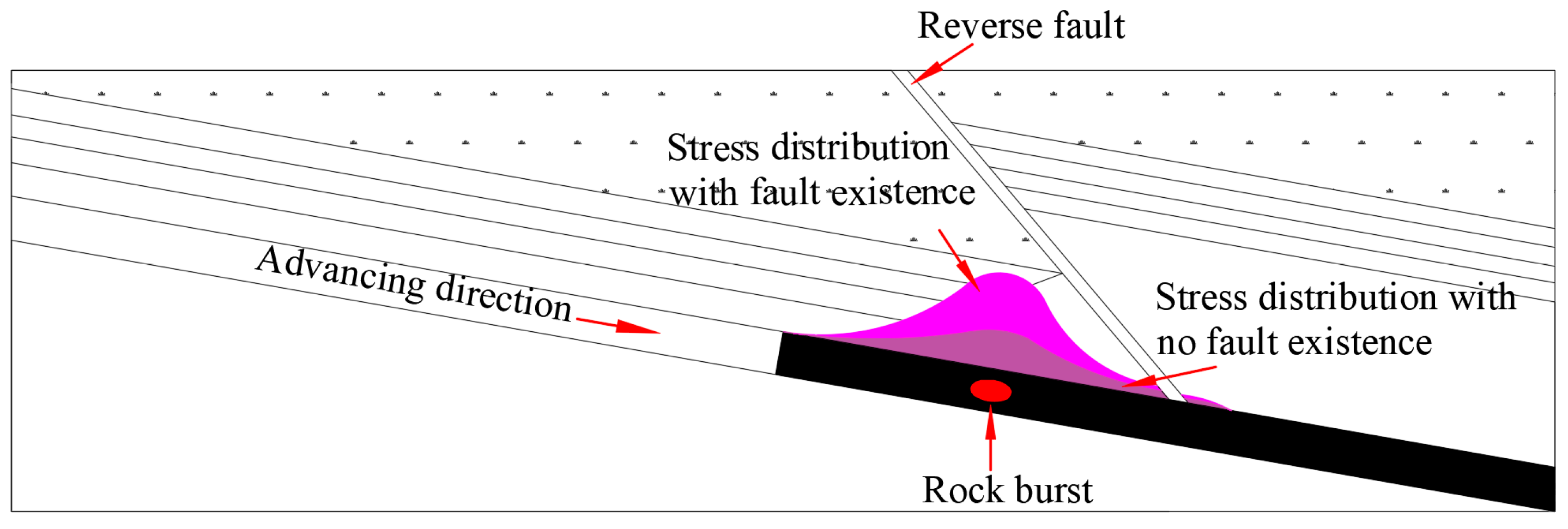
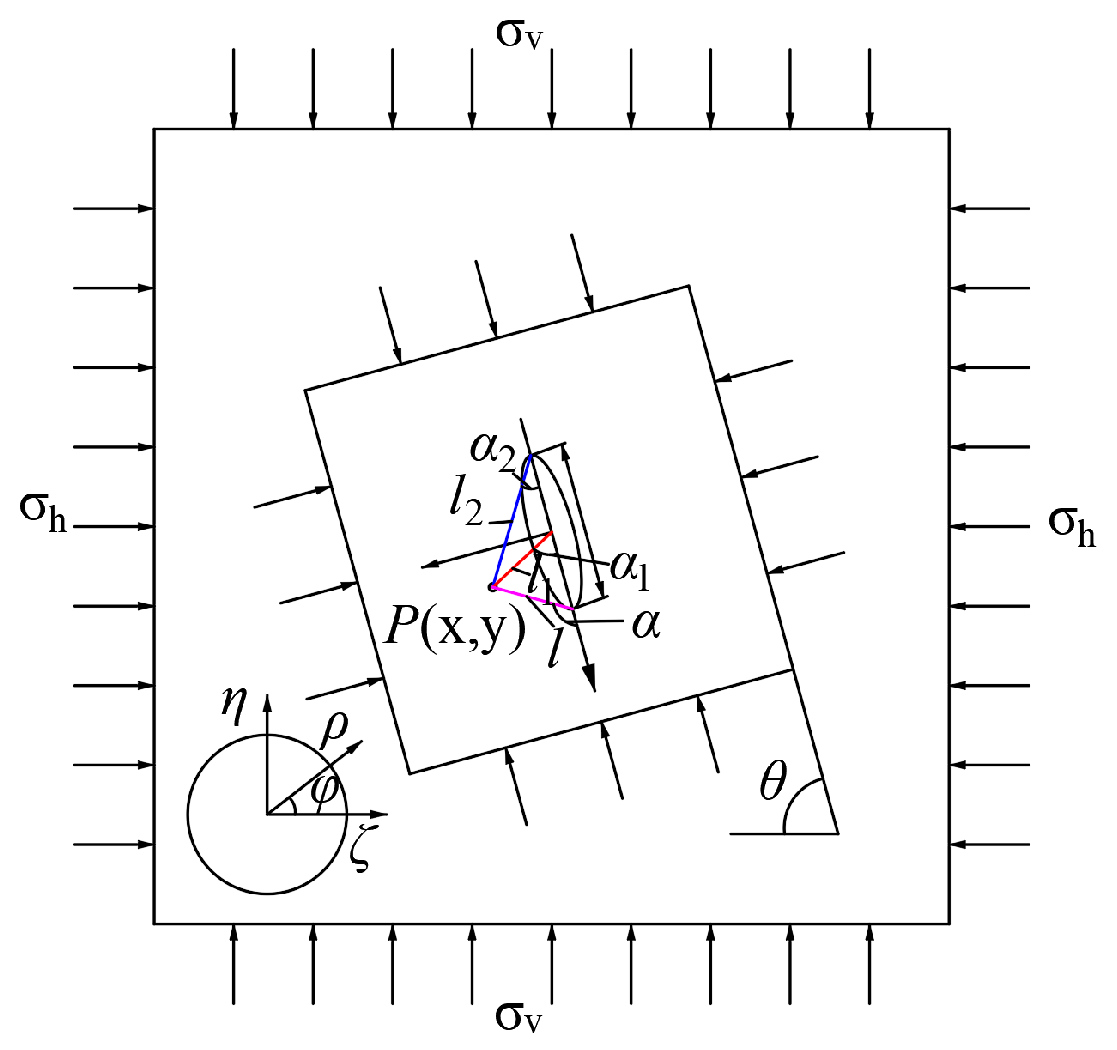


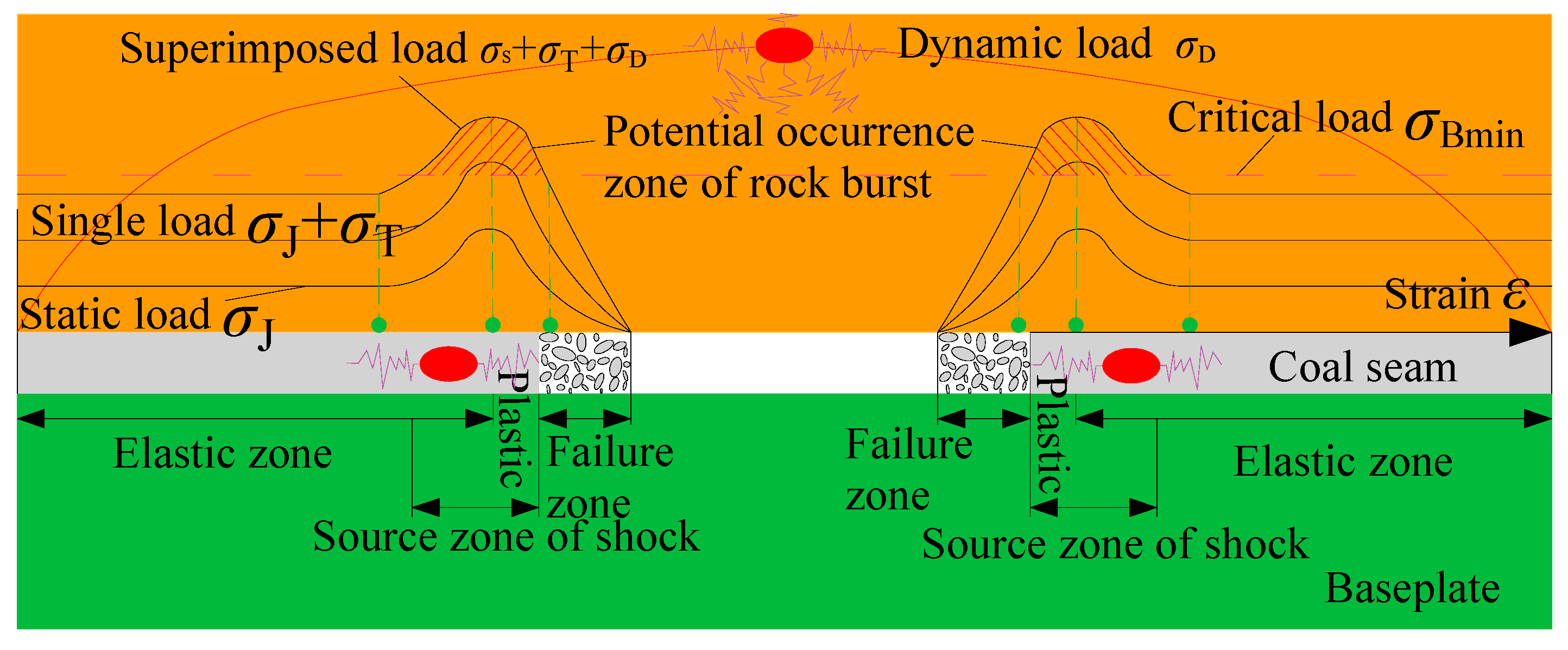
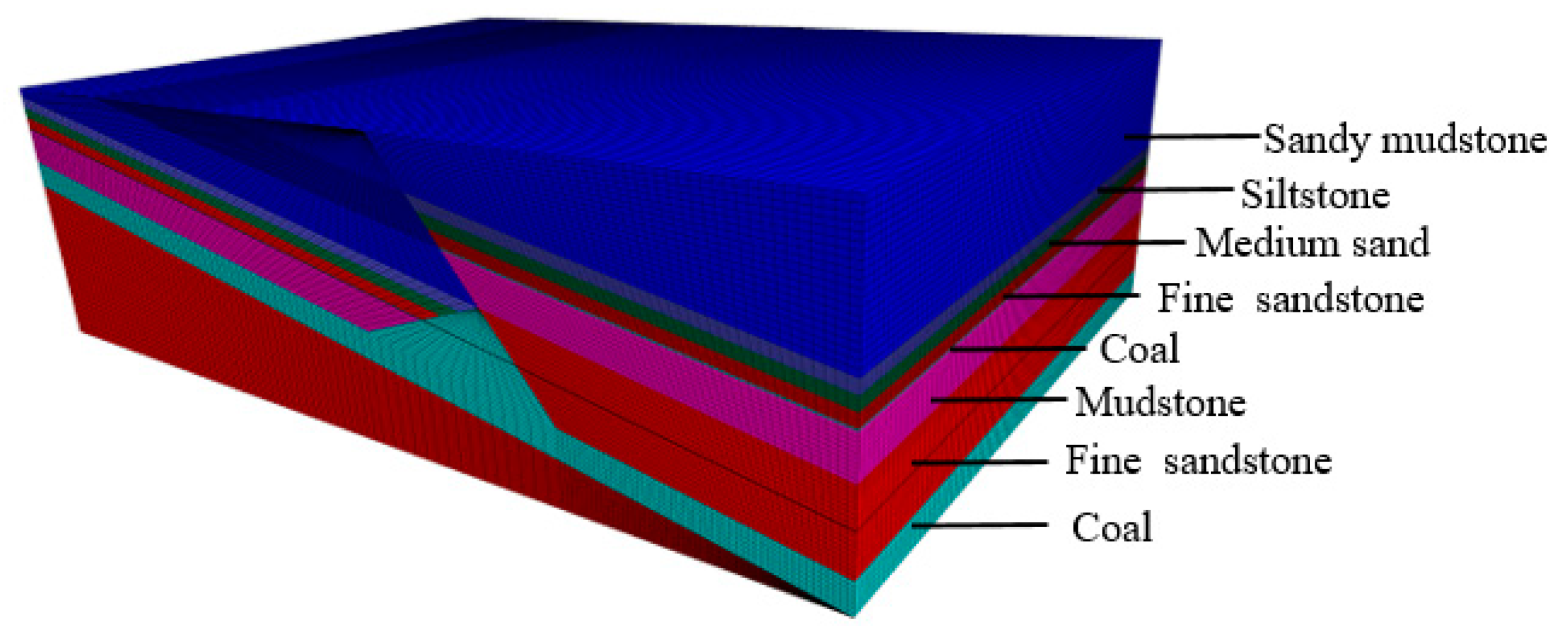
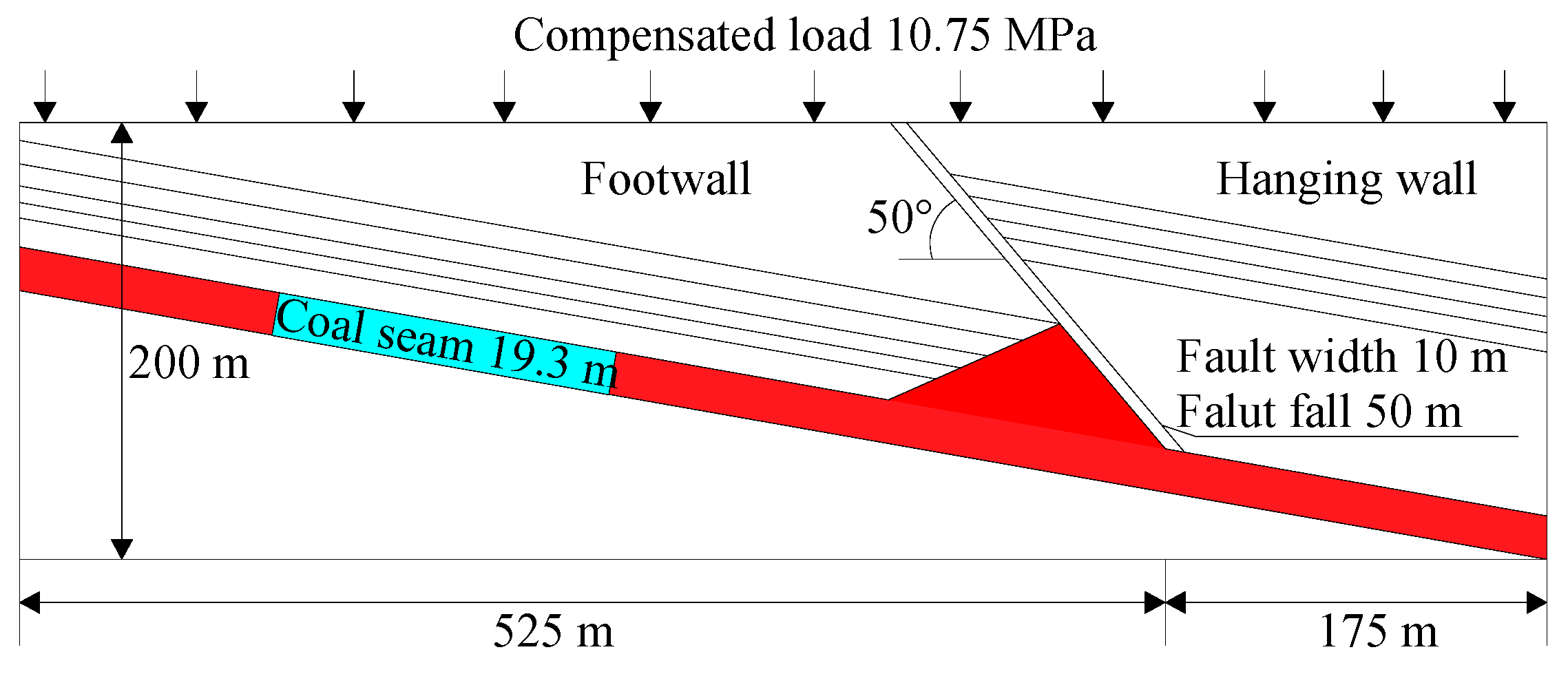

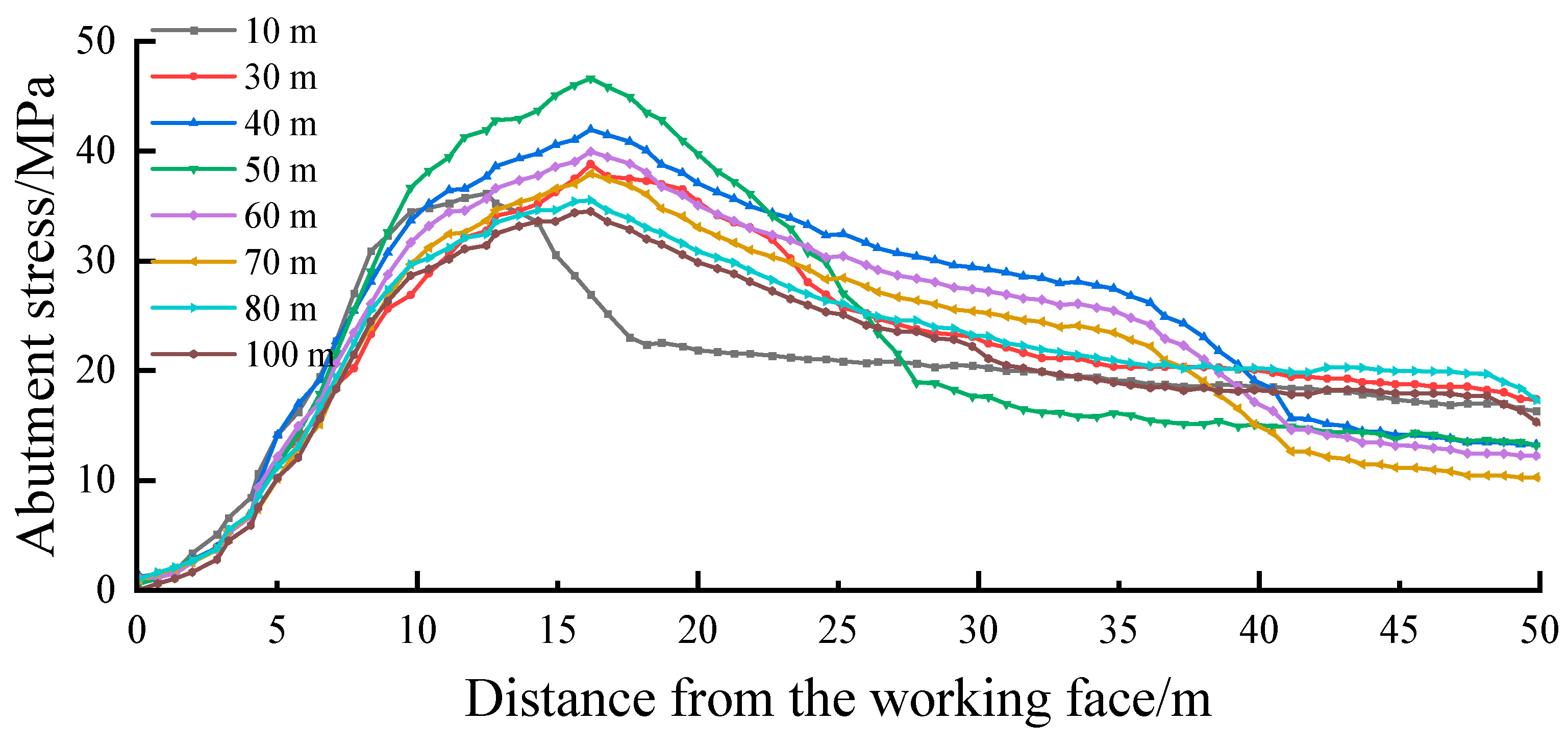
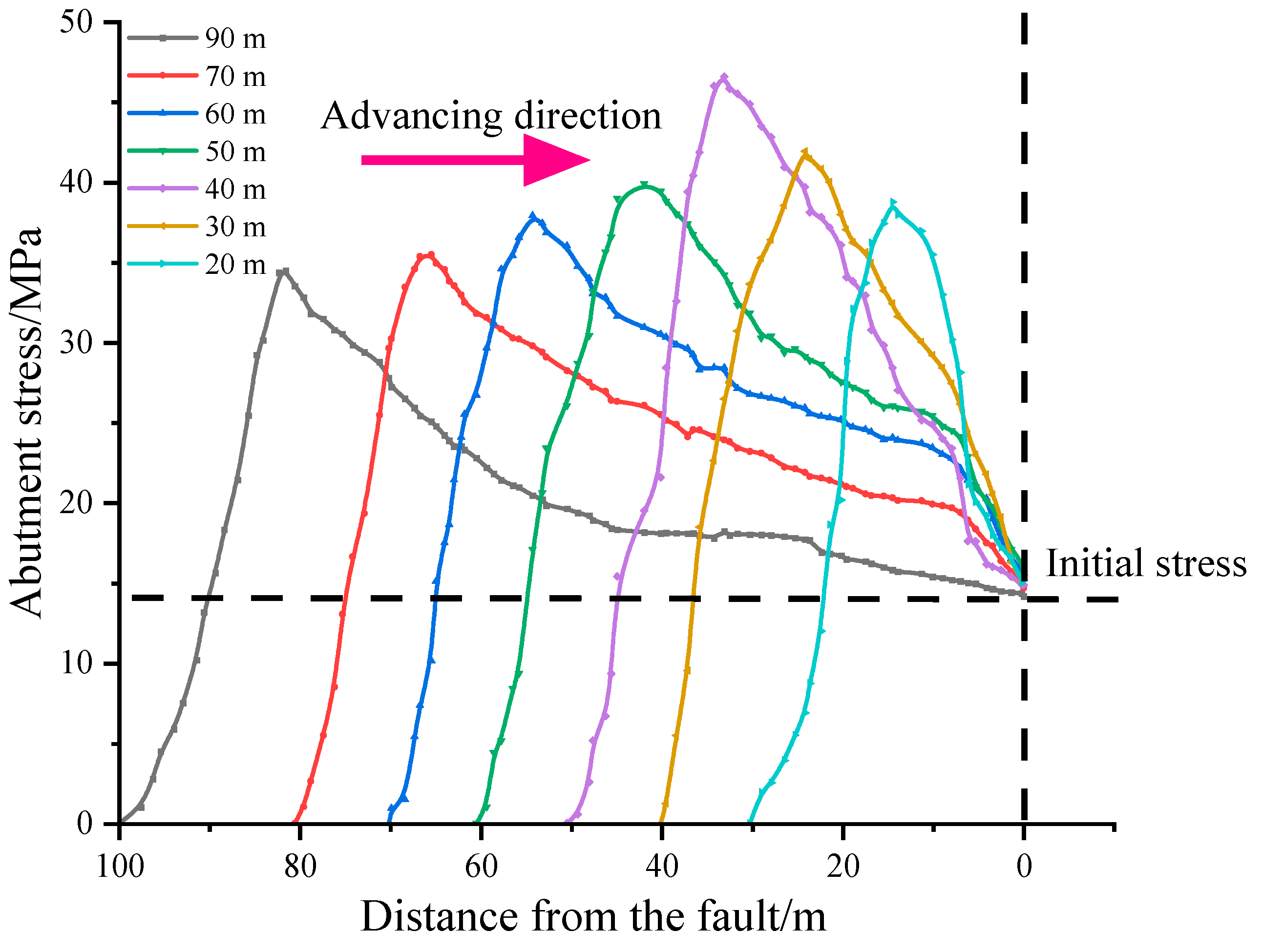
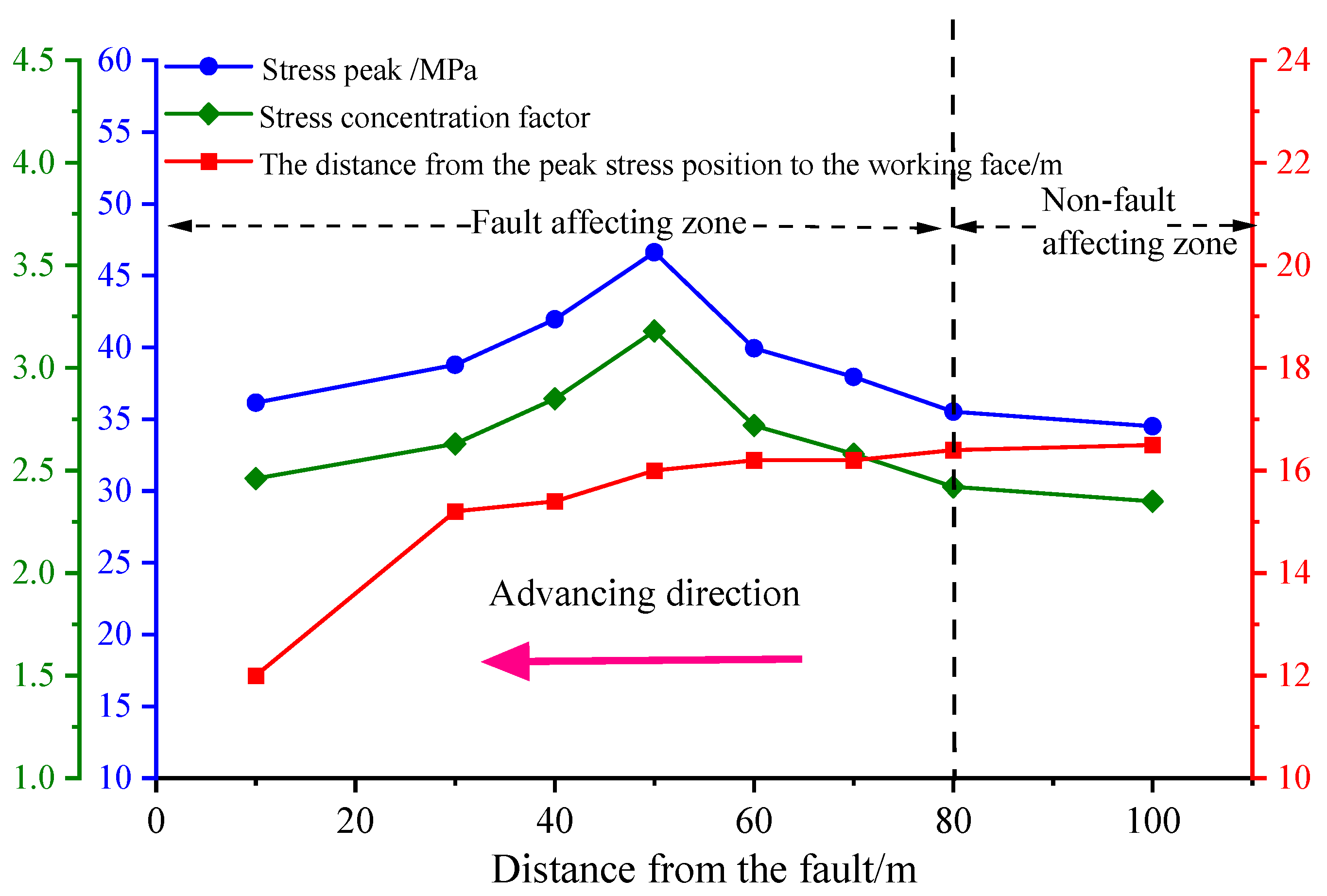
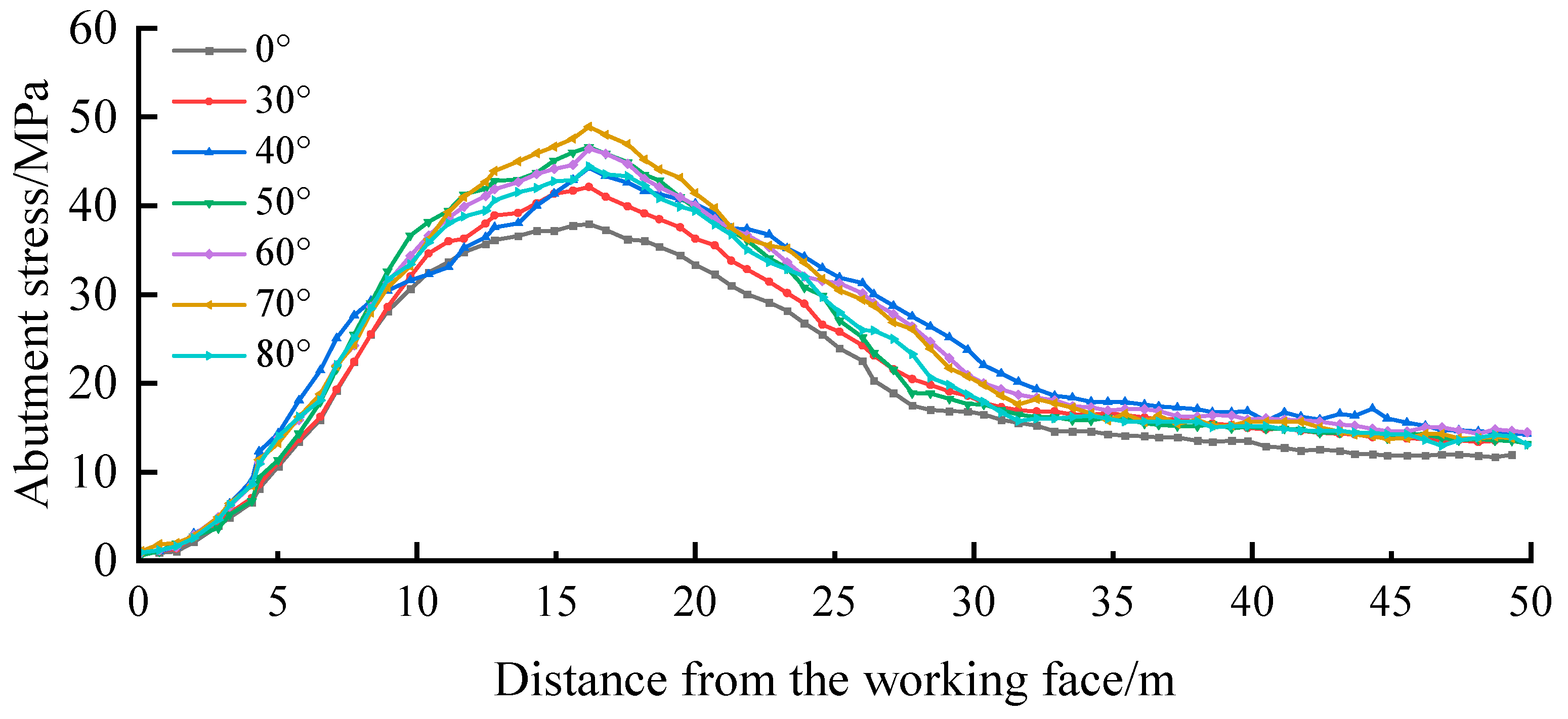
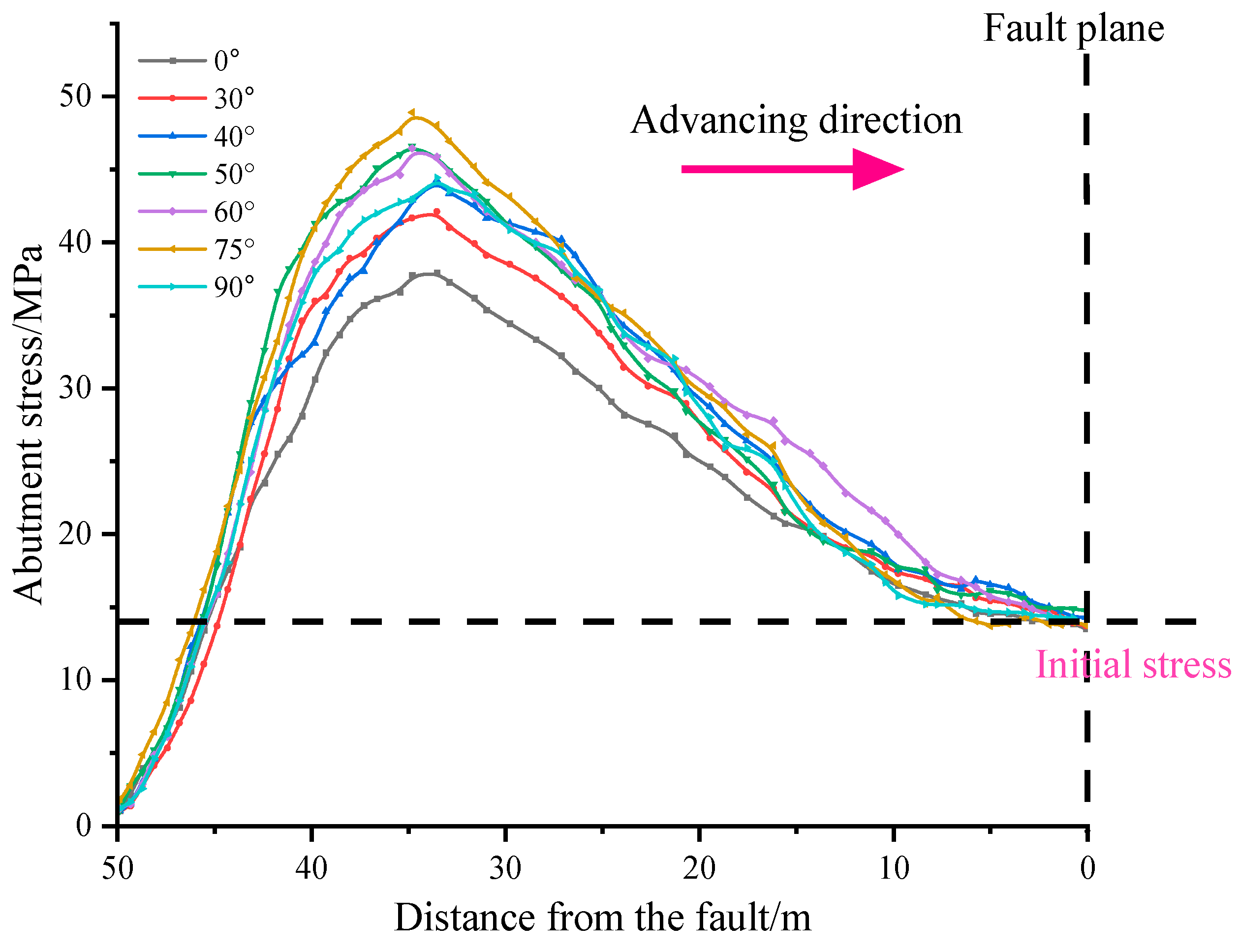

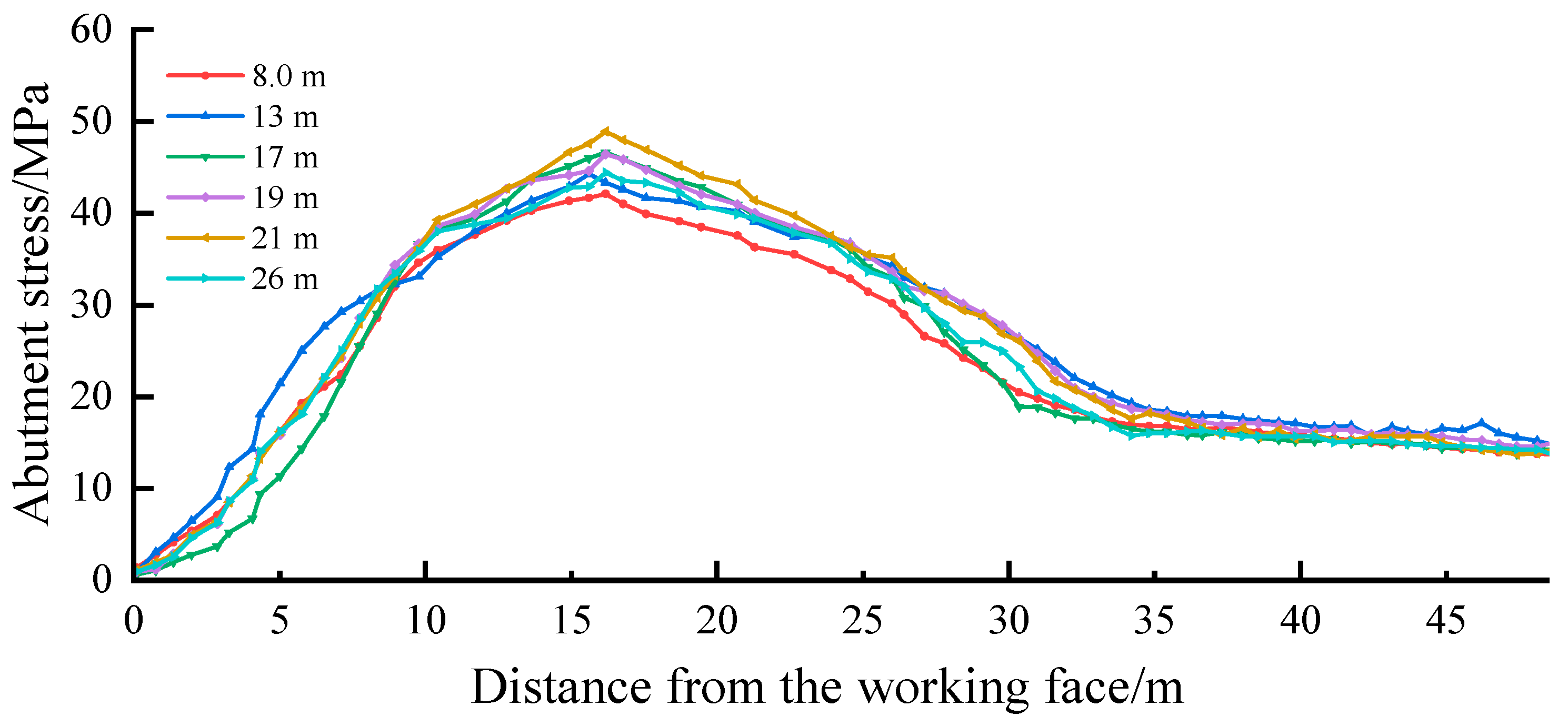
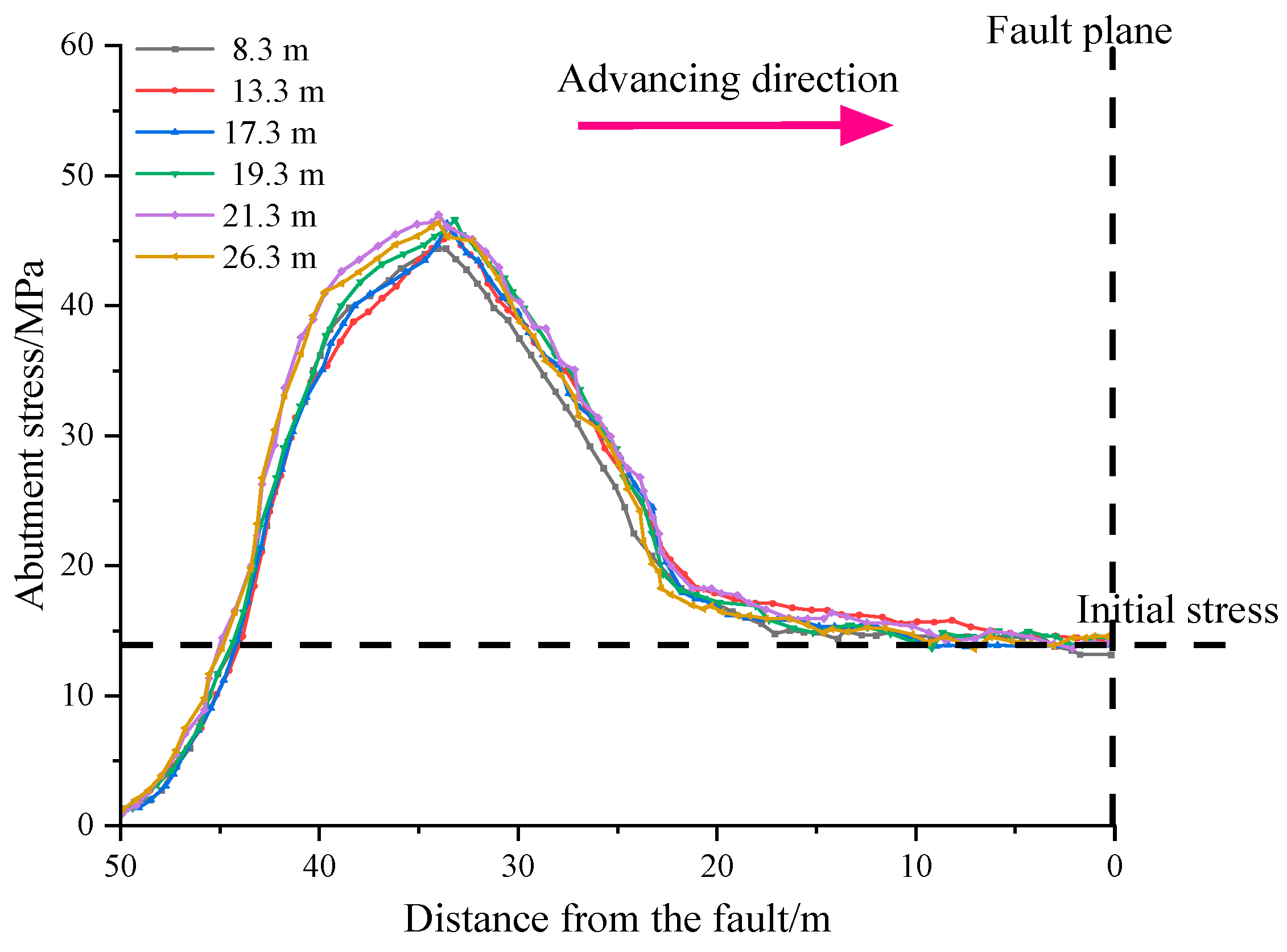

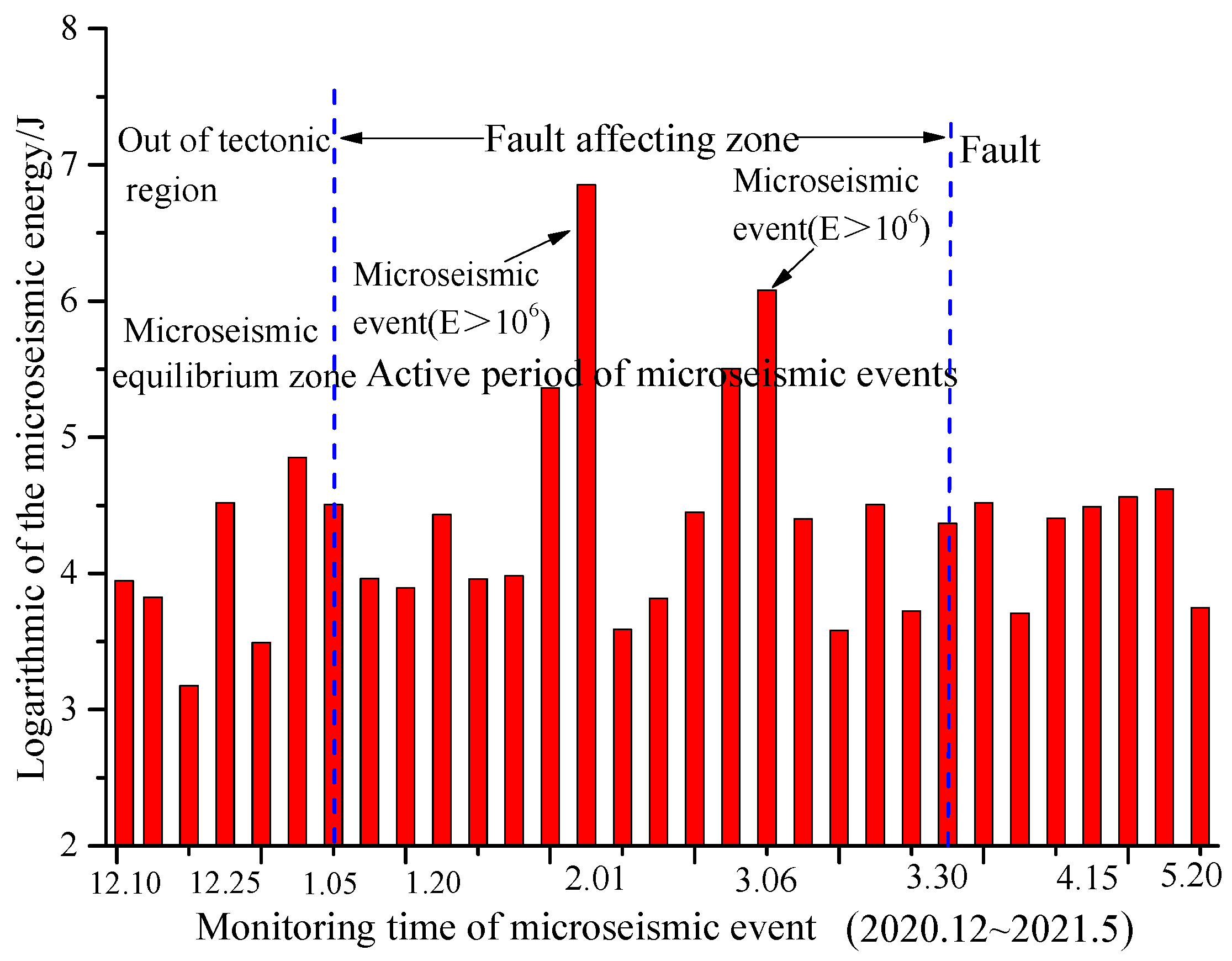
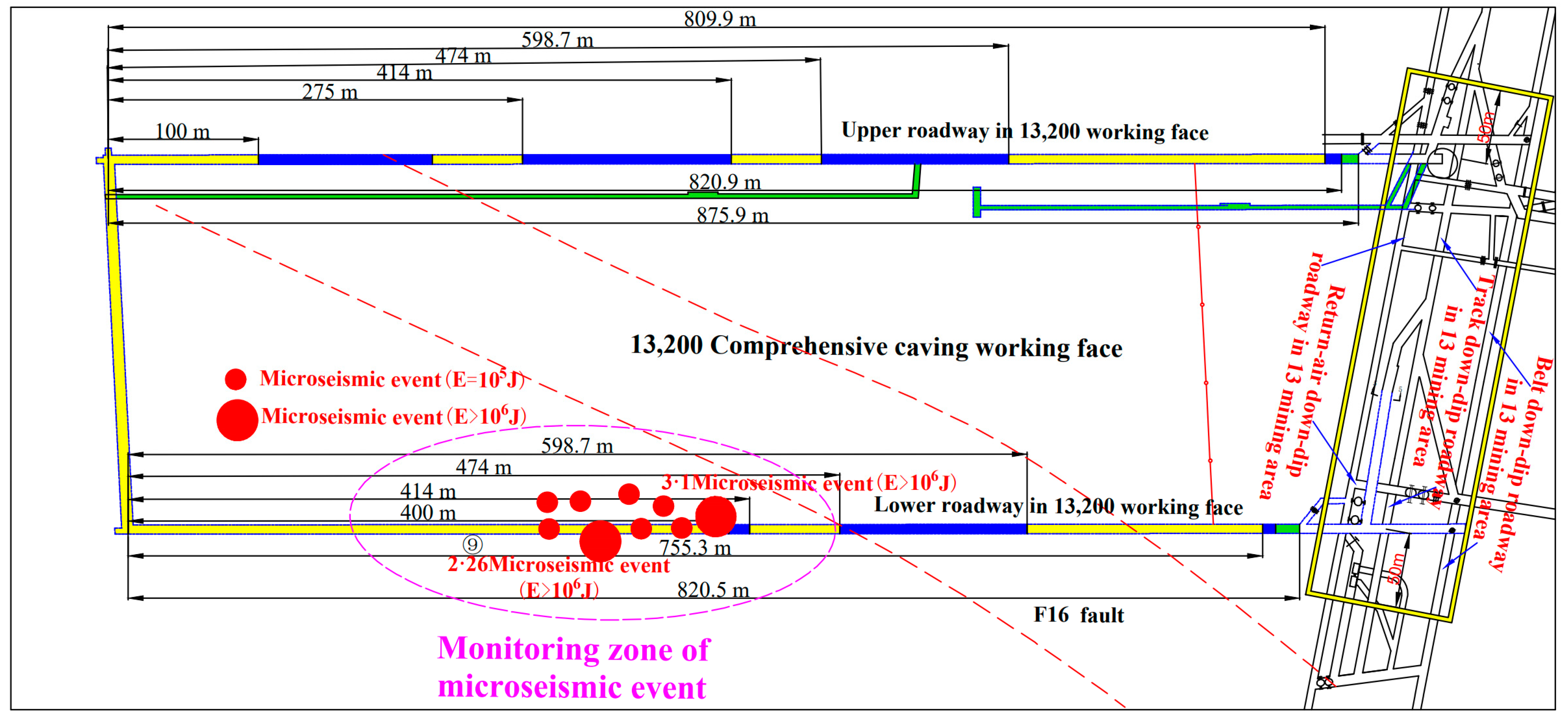
| Lithology | Density (kg/m3) | Bulk (GPa) | Shear (GPa) | Tensile Strength (MPa) | Poisson Ratio | Internal Friction Angle (°) | Cohesion (MPa) |
|---|---|---|---|---|---|---|---|
| Coal | 1344 | 1.6 | 1.4 | 0.4 | 0.25 | 30 | 2.08 |
| Mudstone | 2450 | 10.4 | 7.3 | 2.1 | 0.24 | 35 | 4 |
| Sandy mudstone | 2550 | 12.1 | 9.5 | 2.6 | 0.26 | 37 | 4.66 |
| Siltstone | 2600 | 12.4 | 9.2 | 3.1 | 0.24 | 34 | 4.7 |
| Fine sandstone | 2650 | 16.3 | 12.5 | 4.3 | 0.3 | 38 | 7.5 |
| Medium sandstone | 2600 | 13.5 | 10.1 | 3 | 0.24 | 35 | 5 |
| Lithology | Density/kg/m3 | Bulk/GPa | Shear/GPa | Tensile Strength/MPa | Poisson Ratio | Internal Friction Angle/° |
|---|---|---|---|---|---|---|
| Fault | 1344 | 1.78 | 1.28 | 0.4 | 0.25 | 30 |
Disclaimer/Publisher’s Note: The statements, opinions and data contained in all publications are solely those of the individual author(s) and contributor(s) and not of MDPI and/or the editor(s). MDPI and/or the editor(s) disclaim responsibility for any injury to people or property resulting from any ideas, methods, instructions or products referred to in the content. |
© 2024 by the authors. Licensee MDPI, Basel, Switzerland. This article is an open access article distributed under the terms and conditions of the Creative Commons Attribution (CC BY) license (https://creativecommons.org/licenses/by/4.0/).
Share and Cite
Yang, S.; Wei, X.; Chen, L.; Wang, Z.; Wang, W. Analysis of Rock Burst Mechanism in Extra-Thick Coal Seam Controlled by Thrust Fault under Mining Disturbance. Processes 2024, 12, 320. https://doi.org/10.3390/pr12020320
Yang S, Wei X, Chen L, Wang Z, Wang W. Analysis of Rock Burst Mechanism in Extra-Thick Coal Seam Controlled by Thrust Fault under Mining Disturbance. Processes. 2024; 12(2):320. https://doi.org/10.3390/pr12020320
Chicago/Turabian StyleYang, Suihan, Xiangzhi Wei, Linlin Chen, Zhiliu Wang, and Wen Wang. 2024. "Analysis of Rock Burst Mechanism in Extra-Thick Coal Seam Controlled by Thrust Fault under Mining Disturbance" Processes 12, no. 2: 320. https://doi.org/10.3390/pr12020320





